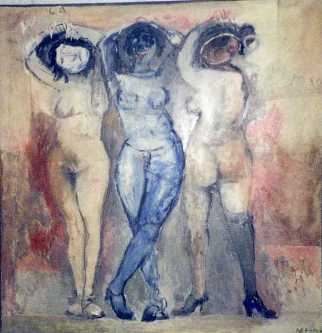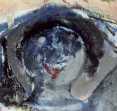
Iakov Levi
Marino
Marini and
“The Coachmaker’s Three Daughters” (Le tre figlie

May
30, 2006
We use up too much artistry in our dreams - and therefore often are impoverished during the day.
(F.Nietzsche, II Human All Too Human, 194)
Freud has
shown that the number 3 is the symbol of the penis[1].
Therefore, three women are equivalent to a female penis, which in
children’s
fantasy is like the one of the male. In Western mythology the
representation of
three women recurs in an obsessive way peculiar to a neurotic symptom.
It is
the expression of the rooted unconscious conviction that the woman
possesses,
or had possessed in the past, a penis similar to that of the male. The
obsessive repetition relieves through the process of catharsis the
anxiety
suffered at the stressful discovery of its absence, which did activate
the
child own castration anxiety.
However, in
Marini’s painting there is something more; one of the three women wears
a sock.
Jean
Baudrillard, dealing with the strip-tease, writes:
…when she is naked she
is much
more adorned than when she is dressed […]. She wears gloves, which cut her arms.
She wears
green, red, or black socks, which also cut her
legs at the level of the thigh […]
The body that the woman worships
through a sophisticated manipulation, and through an intensive
narcissistic
discipline without any weakness, transforms her and her sacred body
itself into
a living penis, which represents the woman’s castration. To be
castrated means
to be covered with phallic symbols. The woman is covered with them, and
she is
constrained into transforming herself into a living penis, if she
aspires to be
desired [2] .
Therefore, the
sock cutting the woman’s leg represents also her own
castration, as in
every hint which associates with “cuts” and “cutting”. It is not casual
that in
the painting the woman wearing the sock is represented with her back
turned to
the spectator, at difference with the other two women, and she does not
shows
her genital like her two companions. The castration’s symbol equivalent
to the
lack of a penis is already expressed by the “cutting” of the sock.
Furthermore,
the third woman, showing a “cut” (the sock cutting her leg), explains
the lack
of a penis in the other two women: “They do not have a penis because
it was
cut”.
Works of
arts are like dreams. They “explain” through the associative link
between the
different elements. As Freud said, our unconscious knows no grammar. If
it wants
to deliver a message, it works by associating components. It does not
use
particles, symbols of denials or other grammatical devices. The first
two women
display a female genital lacking a penis, and
the third
woman explains what happened: it was cut.
The child,
when he discovers the lack of a penis in the woman, side by side with a
tentative of denial, he also gives to himself an explanation that the
father
was responsible for that mutilation[3].
He cut her member, and in this way he “made” of her a woman[4].
Facing Marini’s
painting, the spectator is confronted with an unconscious
content, which was repressed, but was also pressing for recognition.
This work
of art speaks to him to the degree in which this content was indeed
pressing
for recognition. If the repression is total and completely successful,
this
great work of art hardly says anything to him.
However, if the
energetic investment is still active, the work of art will deliver a relief from the sufferance
inherent
to the process of active repression. Seeing outside what is pressing
inside ourselves
represents a relief, even if there is no conscious realization, and
the all
process is worked in the underground. Consciousness may be aware only
of the
subsequent enjoyment.
The enjoyment of a
work of art is a function of its capability to bring
relief to the sufferance inherent to the energetic effort invested in
order to repress
psychic contents charged with anxiety. It can be done only through the
vehicle
of a language that can be understood by our unconscious. This language
is the
music of the work of art, and as such communicates directly from
unconscious to
unconscious. The language, namely the lines, the forms, the colours of the painting are
the
notes of that music. Without it, it will lack the
catharsis' vehicle. Our
unconscious does not understand words, but their music, the tune
accompanying them. If we praise a child by
a threatening voice, the child does not understand the praise but the
threat.
Therefore, it is the tune of the work of art, which expresses the true
contents, namely the sentiment. If the tune is artificial and not
sincere,
there is a shortcut in the communication, which results in an isolation
of the sentiment. The work of art is not
such,
but only a declaration, and no relief can be expected.
Marini’s “Le tre
figlie
”The Coachmaker’s Three Daughters” reminds the archaic phallic triads of Greek mythology: the Erinnyes, the Harpies, the Graiae, and particularly the Gorgons.
The archaic inference
The most famous among the Gorgons was Medusa, who was decapitated – castrated by the hero Perseus (See: S. Freud, Medusa's Head, 1940). Here we have a Greek marble dating 600 B.C. representing Medusa, to day at the Museum of the Acropolis in Athens, which seems to have inspired Marini for his painting.
The archaic reference unconsciously reconnects to our own archaic history; the first nebulous years of infancy, which are removed but are the source of all later anxieties, those same anxieties that the work of art comes to relieve.


Marino Marini: Scenario
[1] Sigmund Freud, "Symbolism in
Dreams"; "Introductory Lectures on Psychoanalysis" (1915-1917)
in The Standard Edition of the Complete Works of Sigmund Freud,
Ed. and
Trans. J. Strachey, Hogarth Press, London 1964, Vol.XV, pp.163-4.
[2] Jean Baudrillard, Symbolic
Exchange and Death, Chap. IV.
[3] S.Freud, "An Infantile Neurosis",
[4] Karl
Abraham: “The Female Castration Complex”, 1920, and
“An Infantile Theory of the Origin of Female
Sex”,
1923.
Links:
Three Women: the Penis
Caravaggio and the Deposizione nel sepolcro